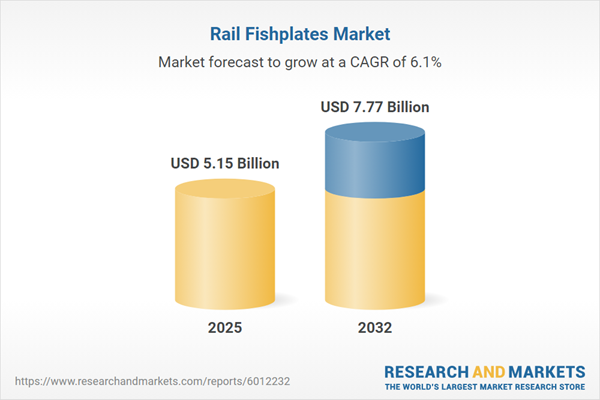Speak directly to the analyst to clarify any post sales queries you may have.
The rail fishplates market is advancing rapidly, influenced by regulatory change, digital transformation, and increasing performance demands. Senior industry leaders are adjusting operational strategies to ensure efficient, resilient, and competitive rail networks amid sector evolution.
Market Snapshot: Rail Fishplates Market Trends
The global rail fishplates market is valued at USD 4.85 billion, with projections reaching USD 5.15 billion within the next year and USD 7.77 billion by 2032. The market's expected 6.05% CAGR is shaped by targeted investments in network upgrades, growing emphasis on adaptable and high-performance track systems, and ongoing digital transformation across the rail infrastructure sector. Manufacturers are prioritizing integrated solutions designed around modern safety expectations and automated rail management, emphasizing reliable products and advanced maintenance practices that match new operational requirements.
Scope & Segmentation: Rail Fishplates Market Overview
- Material Types: Rail fishplates use carbon steel, high manganese steel, stainless steel, carbon fiber composite, fiber reinforced polymer, and glass fiber reinforced polymer. Each material is chosen for its durability, operational efficiency, and ability to meet varied demands across global rail projects.
- Application Domains: Core application sectors include freight lines, high-speed corridors, passenger railways, and urban transit, each segment requiring distinct safety protocols and maintenance intervals.
- End Users: Infrastructure developers, track product firms, and maintenance services seek flexible fishplate solutions to support modernization, manage assets, and adapt to new engineering standards.
- Connection Methods: Options encompass bolted, clip-on, welded, and modular assemblies. Modular and rapid-assembly fishplates are increasingly preferred in busy rail corridors where service continuity is crucial.
- Distribution Channels: Rail fishplate products are supplied through direct sales, partnerships with specialty distributors, and digital procurement platforms, streamlining delivery for international and regional clients.
- Geographic Regions: The Americas, Europe, the Middle East, Africa, and Asia-Pacific shape the market with region-specific investment priorities and regulatory frameworks. These dynamics influence both product evolution and compliance strategies.
- Leading Companies: Key players such as CRRC Corporation Limited, Voestalpine AG, Vossloh AG, Aichi Steel Corporation, Progress Rail Services Corporation, L.B. Foster Company, Pandrol Limited, Gesita S.p.A., Ratnamani Metals & Tubes Limited, and Killick Nixon & Company Limited guide the sector’s technological direction and quality expectations.
- Core Technologies Covered: Integrated condition monitoring sensors, additive manufacturing, digital oversight tools, predictive maintenance analytics, advanced composite materials, and modular assembly processes all contribute to system reliability and easier maintenance cycles.
Key Takeaways for Senior Decision-Makers
- Rapid adoption of composite and polymer-based rail fishplates supports lighter weight, improved vibration control, and extended service life for high-speed and urban transit systems.
- Increased use of digital monitoring and predictive analytics empowers asset managers to execute proactive maintenance and streamline operational resources across network segments.
- Regional differentiation remains important: Asia-Pacific and Middle East operators prioritize expansion, while North America and Europe invest in digital solutions and sustainability practices for current infrastructure.
- Strategic partnerships among manufacturers, operators, and research bodies enable faster product deployment and reduce project lead times.
- The focus on rapid-assembly and modular fishplate solutions enables rail operators to maintain service continuity and minimize unplanned outages in demanding corridors.
Tariff Impact: Navigating a Changing Trade Environment
Changes in U.S. steel and composite tariffs require suppliers to reevaluate sourcing and production methods. Adoption of localized manufacturing and development of adaptive regional supply chains promote market stability, while strong inventory management and diverse supplier relationships ensure timely project completion in an evolving global trade environment.
Market Research Methodology & Data Sources
This rail fishplates market analysis integrates executive interviews from infrastructure, manufacturing, and maintenance fields. The insights are strengthened by expert advisories, financial audits, and sector reviews, providing clear, actionable data for procurement, operations, and technology stakeholders.
Why This Rail Fishplates Market Report Matters
- Senior decision-makers can anticipate industry regulations, technological developments, and optimize global supplier strategies.
- Clear insights into material selection, technology advancements, and regional investment priorities help leadership teams guide asset modernization and future capital planning.
- The report supports operational resilience using compliance and digital tools during market transition phases.
Conclusion
The rail fishplates market is characterized by continued innovation, region-specific adaptation, and supply chain resilience. This report delivers strategic guidance that empowers executive teams to drive modernization and achieve sustained performance in a dynamic sector.
Additional Product Information:
- Purchase of this report includes 1 year online access with quarterly updates.
- This report can be updated on request. Please contact our Customer Experience team using the Ask a Question widget on our website.
Table of Contents
3. Executive Summary
4. Market Overview
7. Cumulative Impact of Artificial Intelligence 2025
Companies Mentioned
The companies profiled in this Rail Fishplates market report include:- CRRC Corporation Limited
- Voestalpine AG
- Vossloh AG
- Aichi Steel Corporation
- Progress Rail Services Corporation
- L.B. Foster Company
- Pandrol Limited
- Gesita S.p.A.
- Ratnamani Metals & Tubes Limited
- Killick Nixon & Company Limited
Table Information
| Report Attribute | Details |
|---|---|
| No. of Pages | 188 |
| Published | November 2025 |
| Forecast Period | 2025 - 2032 |
| Estimated Market Value ( USD | $ 5.15 Billion |
| Forecasted Market Value ( USD | $ 7.77 Billion |
| Compound Annual Growth Rate | 6.0% |
| Regions Covered | Global |
| No. of Companies Mentioned | 11 |









